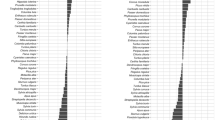Sciurus carolinensis
) have been labor intensive and costly, I demonstrate the use of line transect surveys to estimate gray squirrel density and determine the costs of conducting surveys to achieve precise estimates. Density estimates are based on four transects that were surveyed five times from 30 June to 9 July 1994. Using the program DISTANCE, I estimated there were 4.7 (95% CI = 1.86–11.92) gray squirrels/ha on the Clemson University campus. Eleven additional surveys would have decreased the percent coefficient of variation from 30% to 20% and would have cost approximately $114. Estimating urban gray squirrel density using line transect surveys is cost effective and can provide unbiased estimates of density, provided that none of the assumptions of distance sampling theory are violated.
Similar content being viewed by others
Author information
Authors and Affiliations
Rights and permissions
About this article
Cite this article
Hein, E. Demonstration of Line Transect Methodologies to Estimate Urban Gray Squirrel Density. Environmental Management 21, 943–947 (1997). https://doi.org/10.1007/s002679900078
Issue Date:
DOI: https://doi.org/10.1007/s002679900078




